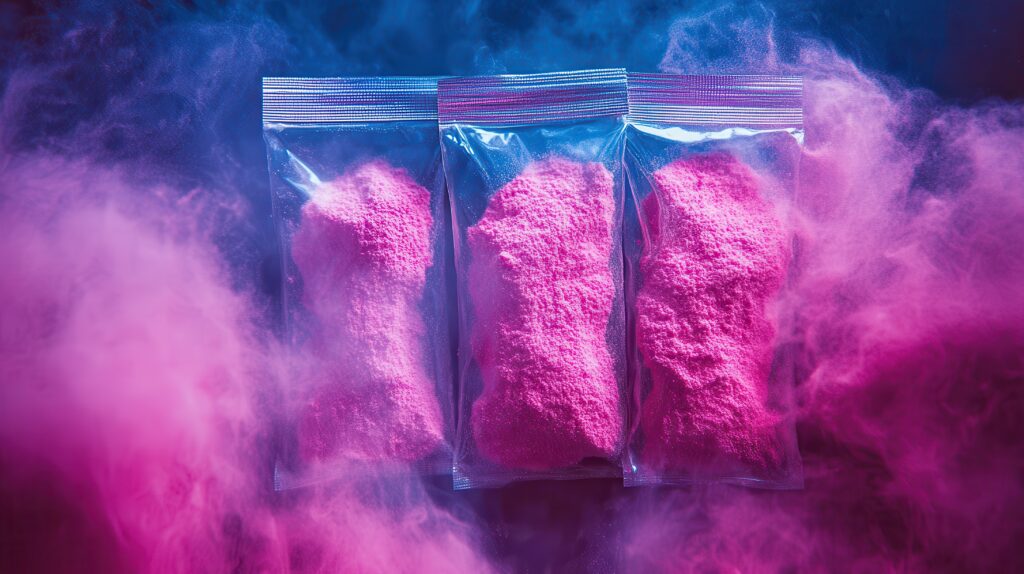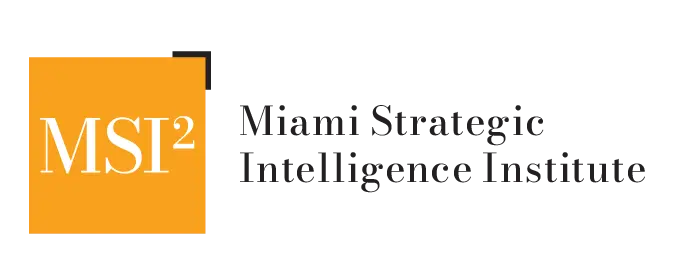08 May Strategic Intelligence Assessment – Pretty Poison: How Tusi Became Latin America’s Most Deceptive Drug Export
By,
Jesús Daniel Romero, Co-Founder and Senior Fellow, MSI² & William Acosta, SME
A synthetic narcotic reshaping the global drug landscape through aesthetics, cartel strategy, and lethal unpredictability
Tusi, widely known as “pink cocaine,” is a synthetic drug cocktail that has rapidly expanded from Latin America to Europe and the United States. Despite its nickname, pink cocaine is not actually cocaine. Instead, it is a visually appealing, often sweet-smelling powder composed of a highly variable mixture of psychoactive substances. Its spread is closely linked to transnational criminal organizations—including Venezuela’s Tren de Aragua (TDA), Colombian and Peruvian trafficking groups, and Mexican cartels such as the Sinaloa Cartel—making it a growing threat to public health, law enforcement, and international security.
Composition and Branding of Pink Cocaine
Tusi is not a singular chemical substance, but rather a brand name for various synthetic mixtures. While early versions in Colombia included methaqualone or 2C-B, modern formulations most commonly contain a combination of:
- Ketamine (a dissociative anesthetic)
- MDMA (ecstasy, a stimulant and empathogen)
- Methamphetamine or other amphetamines
- Caffeine
- Opioids (e.g., fentanyl, tramadol, oxycodone)
- Benzodiazepines
- Other new psychoactive substances (NPS)
The product is typically dyed pink—often with food coloring—and sometimes scented to increase appeal, particularly among young partygoers. Marketed as a “luxury” or “designer drug,” its presentation is crafted to attract users in nightlife and club scenes.

Geographic Spread and Trafficking Networks
Pink cocaine’s production and trafficking are concentrated in several Latin American countries:
- Colombia: The primary origin point and one of the largest producers, where clandestine labs operate without quality control, resulting in dangerous and inconsistent formulations.
- Peru: Functions as both a producer and transit country, often in collaboration with Colombian networks.
- Brazil: Has witnessed a rise in consumption, especially in nightlife settings. Police have dismantled labs linked to synthetic drugs and pink cocaine.
- Argentina: Authorities report growing prevalence in urban areas, prompting concern among health officials.
Mexican drug cartels, including the Sinaloa Cartel, have incorporated pink cocaine into their trafficking operations, using existing routes and laundering mechanisms. Shipments move through Central America and Mexico into the United States and Europe, via air, maritime, and digital pathways.
Dangers and Health Risks
The primary danger of tusi lies in its inconsistent and unpredictable composition. Without laboratory testing, users have no reliable way to know what they are consuming. Key risks include:
- Overdose and Acute Toxicity: The combination of stimulants, depressants, and opioids can cause seizures, respiratory or cardiac arrest, serotonin syndrome, coma, or death.
- Physical and Psychological Effects: Hallucinations, paranoia, panic attacks, memory loss, anxiety, psychosis, and blackouts are commonly reported. Some batches cause severe cardiac events when mixed with caffeine or amphetamines.
- Long-Term Damage: Chronic use is associated with addiction, behavioral changes, and elevated risk of cardiovascular complications and stroke.
- Contamination with Lethal Substances: Fentanyl and other potent opioids have been increasingly detected in samples, leading to fatal overdoses from even small doses.
- Social and Criminal Risks: Use of pink cocaine is linked to impaired judgment, violence, and increased incidents of sexual assault and DUI-related crimes.
- Public Health Impact: In the U.S., Poison Control Centers reported hospitalizations and at least one suspected death due to pink cocaine in 2024.
Production, Distribution, and Law Enforcement Response
Produced in improvised labs with no oversight, tusi is made from inexpensive and accessible chemicals to maximize profits. Its visual presentation—dyed pink and sometimes flavored—is part of a calculated marketing strategy.
Distribution networks involve street gangs, regional trafficking groups, and major transnational cartels. Smuggling methods include vehicles, luggage compartments, and increasingly, online and encrypted platforms.
In response, law enforcement agencies across Latin America, Europe, and the United States have escalated surveillance, cross-border cooperation, and targeted interdictions. The DEA and U.S. Coast Guard have seized large maritime shipments, while European agencies have intercepted tusi at international airports.
Tusi’s Emergence in the United States
Although tusi remains more prevalent in Latin America, its presence is rapidly increasing in the United States, particularly in nightlife and urban entertainment hubs. The Drug Enforcement Administration (DEA) and local agencies have reported tusi-related activity in several key regions:
- New York City: A 2024 study among electronic dance music (EDM) attendees found that approximately 2.7% had used tusi in the past year. The drug’s appeal was highest among Hispanic communities and poly-drug users. Misidentification of tusi as 2C-B or cocaine is common, heightening health risks.
- Miami, Florida: The Miami-Dade Medical Examiner has investigated multiple overdoses linked to pink powder mixtures containing ketamine, MDMA, and opioids. Miami remains a major entry point due to its proximity to Caribbean and South American trafficking routes.
- Texas (Austin and Houston): DEA reports confirm seizures of tusi-laced substances in these cities, often containing heroin, MDMA, and cocaine. The drug has been found in club settings, raising concerns over increasing use among young adults.
- Colorado Springs, Colorado: In April 2025, a DEA-led raid on an underground nightclub yielded the first known seizure of tusi in Colorado. The operation, which involved over 100 arrests, uncovered evidence of trafficking linked to migrant gangs and Venezuelan criminal elements.
- Chicago, Illinois: Law enforcement officials in Chicago are being trained to identify members of Tren de Aragua, the Venezuelan gang known to traffic tusi. Their growing presence has coincided with localized spikes in pink cocaine circulation.
- National Outlook: According to the DEA, pink cocaine has been increasingly encountered in U.S. cities with vibrant nightlife economies, including New York, Miami, Los Angeles, and Chicago. While still limited in scale compared to other narcotics, tusi’s unpredictability and branding make it an emerging public health concern.
Strategic Implications and Recommendations
The global spread of pink cocaine raises multiple strategic concerns:
- Public Health: The drug’s variability and high toxicity present an urgent threat, especially among youth. Harm reduction tools—such as drug-checking services and naloxone kits—must be expanded.
- Criminal Innovation: Cartels are demonstrating adaptability, exploiting synthetic drug trends to diversify revenue streams.
- Enforcement and Intelligence Gaps: The lack of uniform testing standards and the drug’s ever-evolving composition hinder effective enforcement and prosecution.
Conclusion
Pink cocaine—or tusi—is not a single drug but a synthetic blend marketed for its aesthetic appeal and nightlife allure. It is highly dangerous, often lethal, and its trafficking is controlled by increasingly sophisticated transnational criminal networks. Addressing the threat requires expanded intelligence operations, regional law enforcement cooperation, and a robust public health strategy.
References
- ACS Publications. (2024). Synthetic drug mixtures and new psychoactive substances: An analytical review of regional samples. American Chemical Society. https://doi.org/10.1021/acsomega.4c00123
- Drug Enforcement Administration (DEA). (2024). National Drug Threat Assessment 2024. U.S. Department of Justice. https://www.dea.gov/documents/2024/03/12/2024-national-drug-threat-assessment
- Elle. (2024, March 15). The rise of “pink cocaine”: Latin America’s deadly designer drug now hitting Europe’s party scene. https://www.elle.com/culture/a43532267/pink-cocaine-latin-america
- Newsweek. (2024, April 8). DEA seizes record shipment of pink cocaine linked to Venezuelan gang. https://www.newsweek.com/dea-pink-cocaine-venezuela-tren-aragua-2024
- Miami Herald. (2024, February 22). Pink cocaine bust in Miami reveals synthetic blend laced with ketamine and fentanyl. https://www.miamiherald.com/news/local/crime/article276543601.html
- United Nations Office on Drugs and Crime (UNODC). (2023). Synthetic drugs in Latin America: Regulatory gaps and rising threats. https://www.unodc.org/documents/scientific/SyntheticDrugs_LatinAmerica2023.pdf
- Colorado Springs Gazette. (2025, April 18). DEA raids Colorado nightclub, uncovers pink cocaine linked to Venezuelan cartel. https://gazette.com/news/colorado-springs-dea-tusi-raid-2025
- European Monitoring Centre for Drugs and Drug Addiction (EMCDDA). (2024). Emerging drug trends in Europe: The case of pink cocaine. https://www.emcdda.europa.eu/publications/alerts/2024/pink-cocaine
- Substance Abuse and Mental Health Services Administration (SAMHSA). (2024). Synthetic drugs and youth risk: 2024 update. U.S. Department of Health and Human Services. https://www.samhsa.gov/data/report/synthetic-drugs-2024
